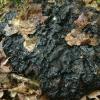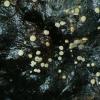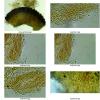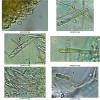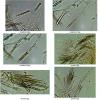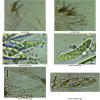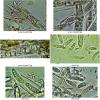
16-08-2017 19:20
 Bernard CLESSE
Bernard CLESSE
Bonsoir à tous,Hier j'ai trouvé, sur vieux polyp

16-08-2017 20:48
 Marc Detollenaere
Marc Detollenaere
Dear Forum, Today I found a small sisk-shaped fru

14-08-2017 10:24
 David Vaudoré
David Vaudoré
Hello,does someone have this publication, please?I

19-04-2017 19:09
Hello,Does anyone has a PDF of :Kutorga, E & H

15-08-2017 15:06
 William Slosse
William Slosse
Good afternoon everyone,I found following species

10-08-2017 20:05
Recolected in Norway. 28.07/17. Ascomas growing on
Asco sur Inonotus dryadeus
Bernard CLESSE,
16-08-2017 19:20
 Bonsoir à tous,
Bonsoir à tous,Hier j'ai trouvé, sur vieux polypore pourri (Inonotus dryadeus) au pied d'un chêne, cet ascomycète.
a) paraphyses hyalines, cylindriques, septées, à contenu réfringent
b) spores subfusiformes, arquées, remplies de guttules et triseptées à maturité : 18-24x5-6,5
c) asques IKI-, à crochet à la base
d) poils serrés, ± subulés, arrondis au sommet, à contenu réfringent
Une idée ?
Bernard
Kosonen Timo,
17-08-2017 09:03

Re : Asco sur Inonotus dryadeus
Hi Bernard,
I think we are somewhere in the world of "bald" discos with strong IKI reaction in the paraphyses (the same VB visible in your photos turns amber). Phaeohelotium/Calycina/Trabinella - just shooting names (from Zotto's folders). Maybe Zotto has a good suggestion for this big-spored species. Maybe this one also falls into "Pezizellaceae", otherwise the big picture is still unclear here as far as I know...
Timo
I think we are somewhere in the world of "bald" discos with strong IKI reaction in the paraphyses (the same VB visible in your photos turns amber). Phaeohelotium/Calycina/Trabinella - just shooting names (from Zotto's folders). Maybe Zotto has a good suggestion for this big-spored species. Maybe this one also falls into "Pezizellaceae", otherwise the big picture is still unclear here as far as I know...
Timo
Bernard CLESSE,
18-08-2017 23:31

Re : Asco sur Inonotus dryadeus
Hi Timo,
Thank you for your opinion !
I have done some photos of the asci that are well IKI + and not IKI- as I had previously reported. Apparently, the reaction does not come on.
Thank you for your opinion !
I have done some photos of the asci that are well IKI + and not IKI- as I had previously reported. Apparently, the reaction does not come on.
I also observed the excipulum that seems typical. I see clavate cells.
Best regards,
Bernard

